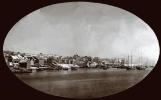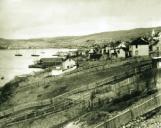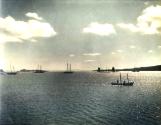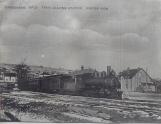2
A view of Carbonear probably just after the turn of the century. It was to this community that William Hawker came from Bere Regis, England in 1852. He went to work with the English firm of Pack, Fryer & Gosse which had a branch of their company in Carbonear, Newfoundland.4
A view of Carbonear waterfront taken from the beach. The schooners in the harbour were probably involved in the international salt-fish trade.6
Carbonear, with its celebrated past and its people of courage and vision, remains one of Newfoundland's scenic and industrious towns. Its sloping hills reach down and gently embrace a safe harbour. The streets with their houses, gardens, trees, and flowers decorate and embellish it. This photograph was taken from the Harbour Rock Hill area.Even today, when diminishing resources have turned many Newfoundland communities into ghost towns, Carbonear remains a vibrant place.
Towns like this are more than landscapes and seascapes. They are people. It is from this vantage point that this archive was compiled.
8
A typical day on the harbour in Carbonear. Circa 191010
This photo is a Newfoundland Quarterly print and shows Carbonear in the year 1907. It has the caption 'Easter Souvenir, 1907.' Under the photograph is a poem written by M. J. Hawker titled "Town of Carbonear".It reads, " Historic town of Carbonear,
Surrounded by its sloping hills,
And lying in a valley fair,
Wherein flow many rippling rills."
This poem and a brief religious Easter verse extend wishes for a Happy Easter-tide and are signed by W.C. Hawker, Superintendent, St. James Sunday School, Carbonear.
W. C. Hawker was the father of Manoah.
12
It is possible that Manoah Hawker is in this photograph. Written on the back of the photo: "I am in this picture near Rev. Maidment." Manoah was very involved with church activities and served on numerous committees of the St. James Church of England parish in Carbonear.Although this church has had some additions to its facade since this picture was taken, it is a beautiful building and is still being used by the parishoners today. It is one of the oldest churches in the area.






